We played the final session of our Lost Mine of Phandelver campaign this weekend. It was a longer session than usual, which was devoted entirely to the exploration of the Wave Echo Mine. However, “longer” in my hands is still fairly short – it was about four hours in total. The exploration of the mine can take a lot longer, especially if you play up the claustrophobic nature of the mine and have more role-playing, but this session was very combat-heavy and dedicated to finishing the adventure. (Our next session will begin Tomb of Annihilation!)
Unusually for my sessions, I used miniatures. Yes, I own a lot of miniatures – over 3,000 of them at last count – but these days I prefer Theatre of the Mind play to allow games to proceed quickly without the need to keep setting up a grid and the minis. However, there are times when it’s a good time to use them, and this was one of those times.
Along with the miniatures, I brought a selection of my Dwarven Forge cavern tiles. I didn’t bring all of them; just enough to assemble the rooms I needed.
Thus, the party entered the mine…
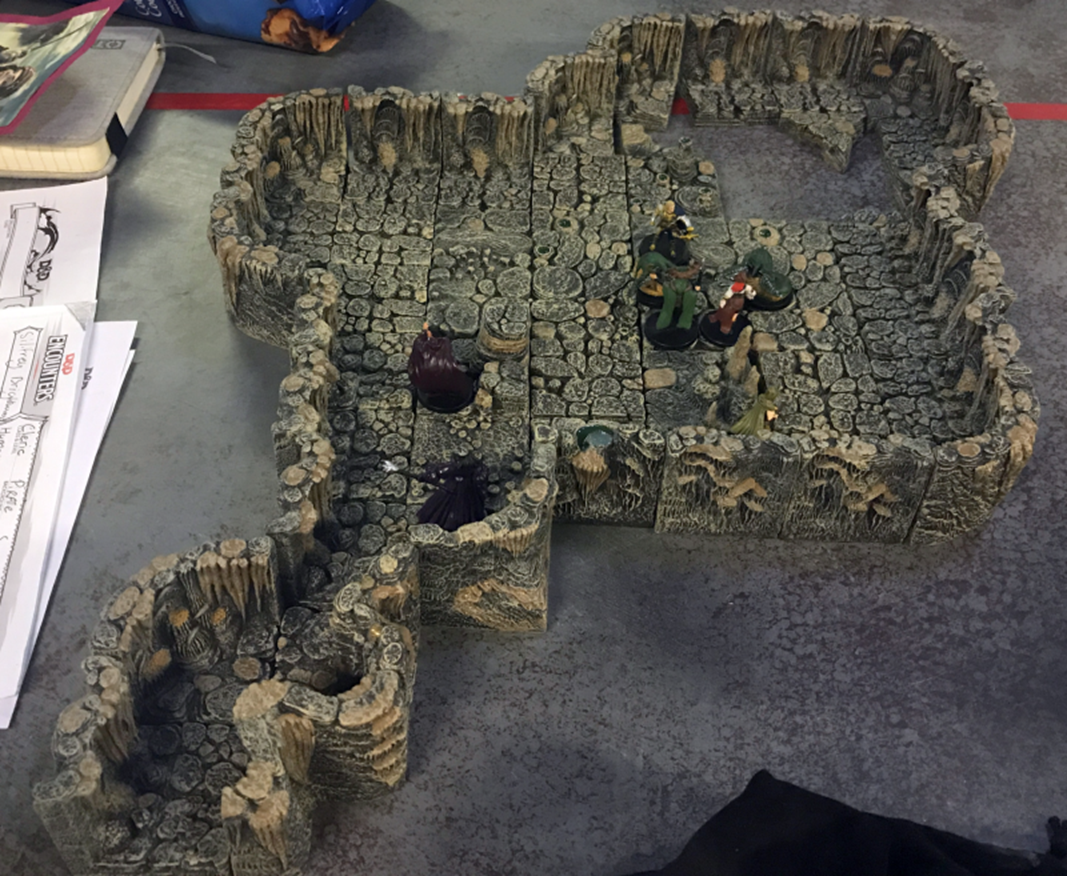
It took very little time before we got to the first combat: a “random” encounter against two grick. The rogue and ranger took cover behind some of the stalagmites and columns in the chamber, and the druid and cleric quickly found themselves in melee, with the sorcerer hanging back and the paladin making his way around to attack the grick from behind. The druid’s shillelagh spell was quite effective – creatures with resistance to non-magical weapons tend to cause low-level groups difficulty.
People with a lot more money and time than I do have created the entire mine with the split levels it has; I couldn’t be bothered. Instead, a lack of tiles indicated the 20-foot deep pit the gricks crawled out of – and which had the tunnels that led further into the mine.
I chose to begin the session with a combat, and so chose one from the random encounter table; rather than just having the players wander around the mine until they found something, we started with a bang and then continued from there.
I didn’t bother setting up the terrain for the corridors they explored. It takes a lot of time for little benefit. The terrain came out when the combat began.
The next combat was against a group of five bugbears; the group wanted to surprise them by opening the door “quietly”, but I generally don’t allow that to happen – the door creaks, the bugbears are alerted. Old D&D had surprise through doors be 33% of the time (for both sides unless one listened at the door first), but that doesn’t happen in 5E that much as I run it. I discovered I hadn’t brought in enough bugbear miniatures, so I did what most people do – used proxies! The undead minis represented two more bugbears; if a bugbear mini was slain, I replaced the undead with the slain mini to make it work better.
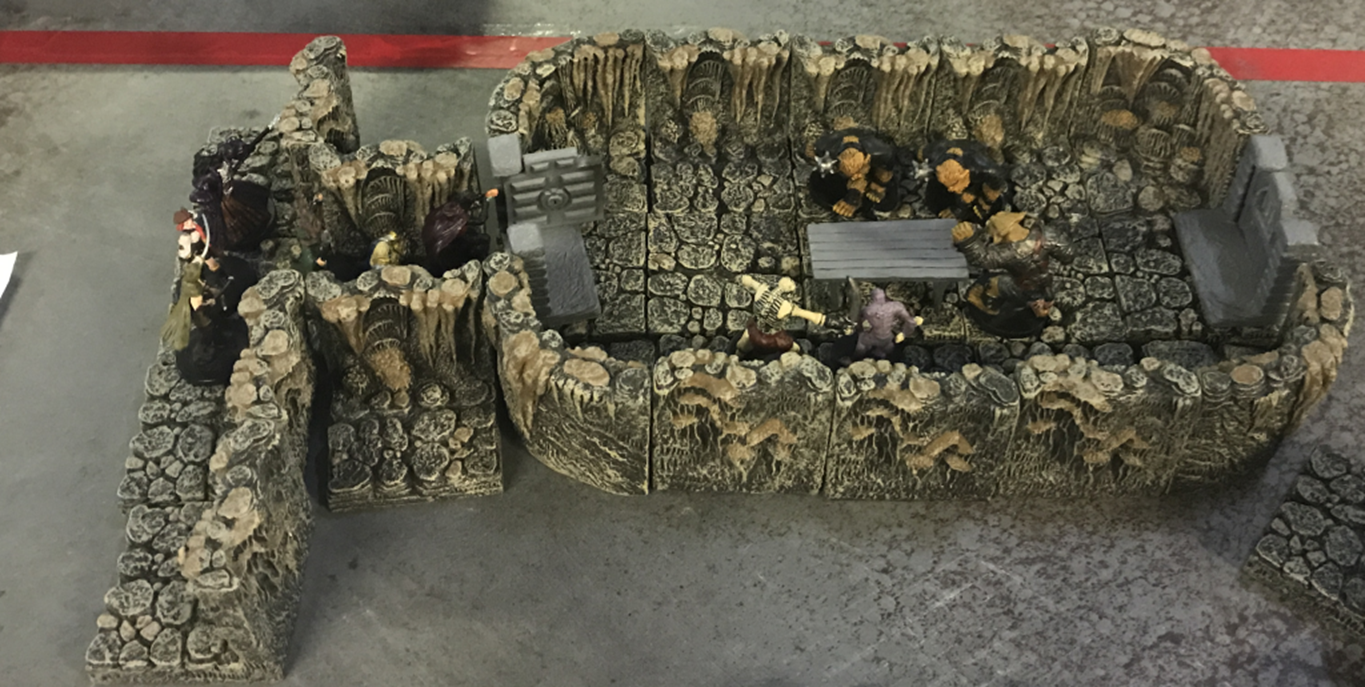
The distinguishing feature of this combat were the cramped quarters everyone was fighting in. With spaces occupied by allies counting as difficult terrain, it was very difficult indeed for the party to get into the room; especially after the bugbears trapped them at the doorway. The paladin was hit by a critical hit, which did a LOT of damage, and the cleric was hard-pressed to keep the paladin alive!
The adventure’s map says the corridor leading to the room is 10 feet wide, but the dungeon tiles reduced that to 7.5 feet – enough for only one PC to stand abreast. That’s really tricky; you have to be careful when using tiles that you don’t reduce space so much that players can’t participate. I made sure in later combats that the corridors were wider. It’s one reason I like Theatre of the Mind – the corridors allow people to participate even when they couldn’t if minis were used!
The next fight was in a split-level cave. This one was harder to represent – I didn’t have enough tiles, so only the first row of the higher levels on each side was created. I expected most of the combat to take place down below, anyway.
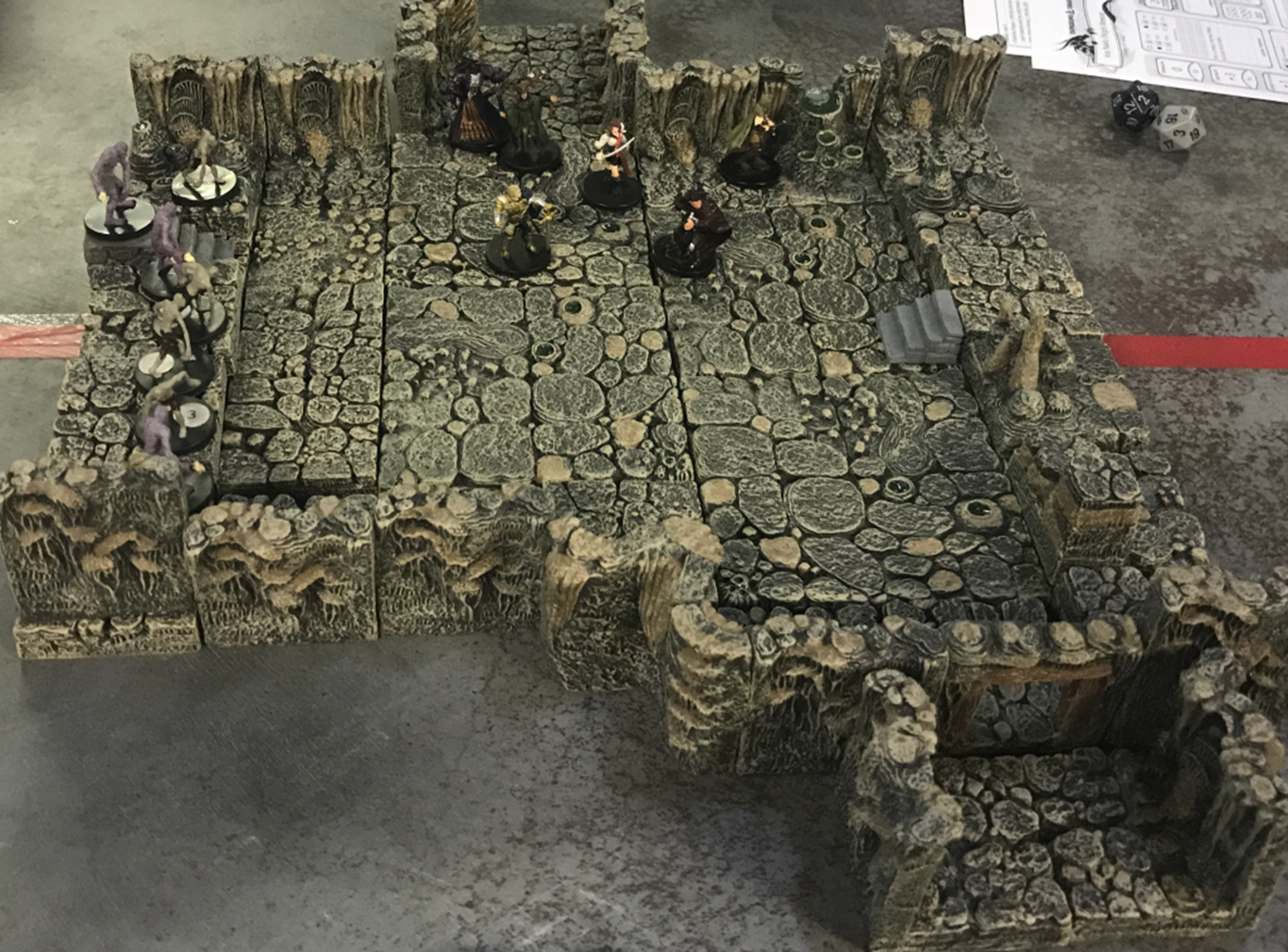
I’ve run this battle a few times now (as I’ve run Lost Mine of Phandelver quite a few times), and it can be a really tough battle: on the left you can see the nine ghouls, all ready to throw themselves at the party. That’s more than enough to cause a Total Party Kill, unless the adventurers run or – as they had in this case – a cleric ready to Turn Undead. That sent most of the ghouls scuttling off, and the adventurers were easily able to deal with the rest – although the paladin spent a turn paralysed!

The undead miniatures – ghouls and ghasts – are amongst the oldest in my collection. The light grey ghoul miniatures come from the very first set of D&D Miniatures from 2003: “Harbinger”, was its title. Miniature technology may have improved since then, but I’ve a lot of fondness for that first set that allowed me to actually collect lots and lots minis – and not have to paint them!
Painting miniatures is something I can do, but it is very time-consuming, and takes me away from playing the game (and writing about it!) The cavern tiles were pre-painted; my first set of dungeon tiles weren’t – you can see a few in use as stairs and doors here – and I’ve never really found time to properly paint then. A grey primer is about it!
The next battle, against zombies and a flameskull, took place in a REALLY BIG ROOM! And another one with a split-level. The tabletop came into play again…
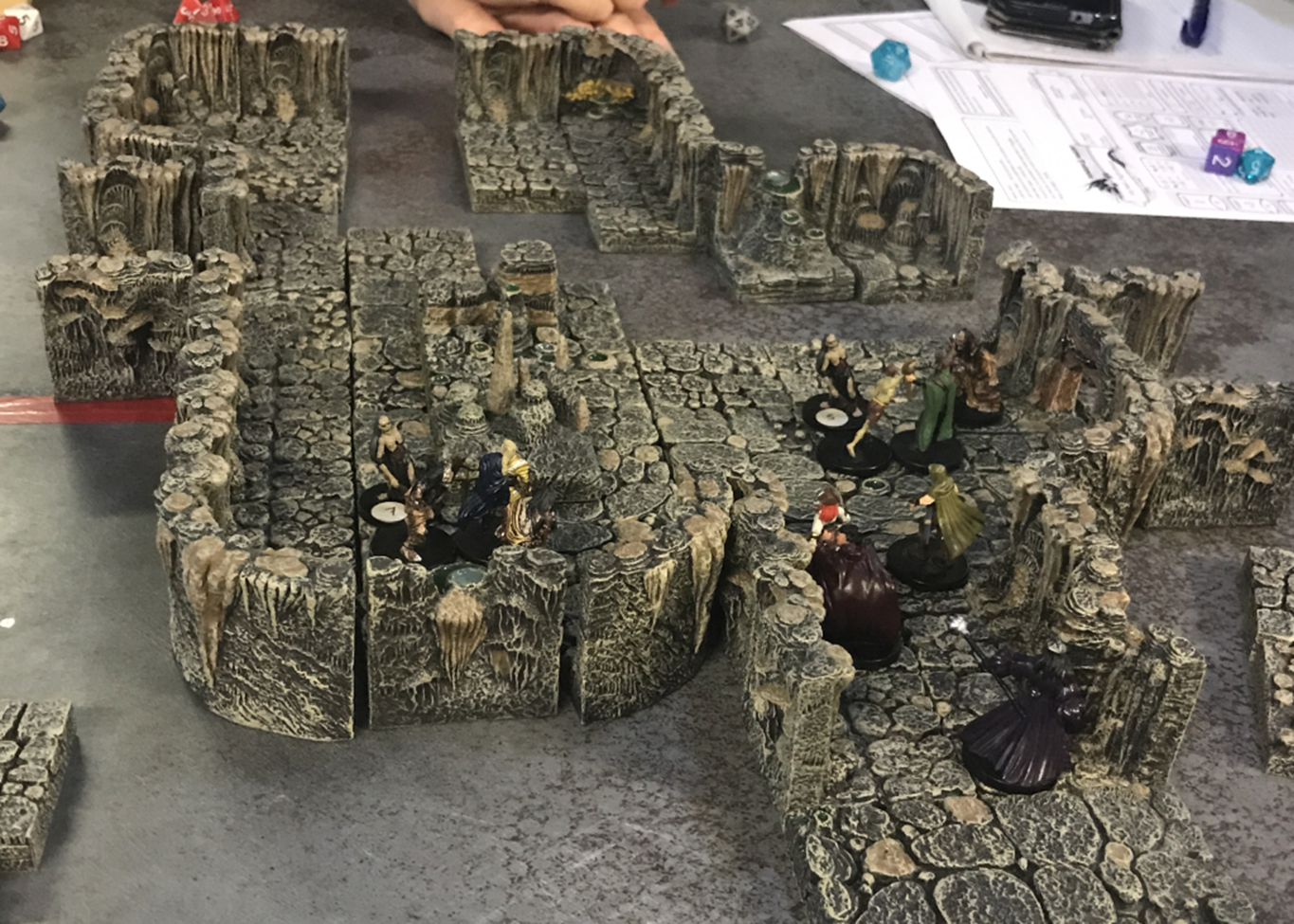
Things could have gone really badly here, because the party were all bunched up in the opening passageway when the flameskull cast fireball on them. A party of third and fourth level characters. I expected at least one death – possibly all – but every single player rolled high on the Dexterity saving throw, and only one character even fell unconscious! It was very, very lucky.
A wand of magic missiles found in an earlier room, plus the sorcerer casting the same, managed to destroy the flameskull before it got to attack again, and after that the zombies fell pretty quickly.
I do actually own a flameskull miniature, but I only took a photograph after it had been destroyed. Some of the zombie miniatures here also date back to that first D&D Miniatures set in 2003!
A long rest was called for at this point – and I made sure they took it outside of the cave, where they wouldn’t be suddenly ambushed by monsters!
The next fight? We were getting near the end – a drow supervising a few bugbears. The giant spider is the druid, who wanted to cause an impression. He certainly did – the drow will never be the same!
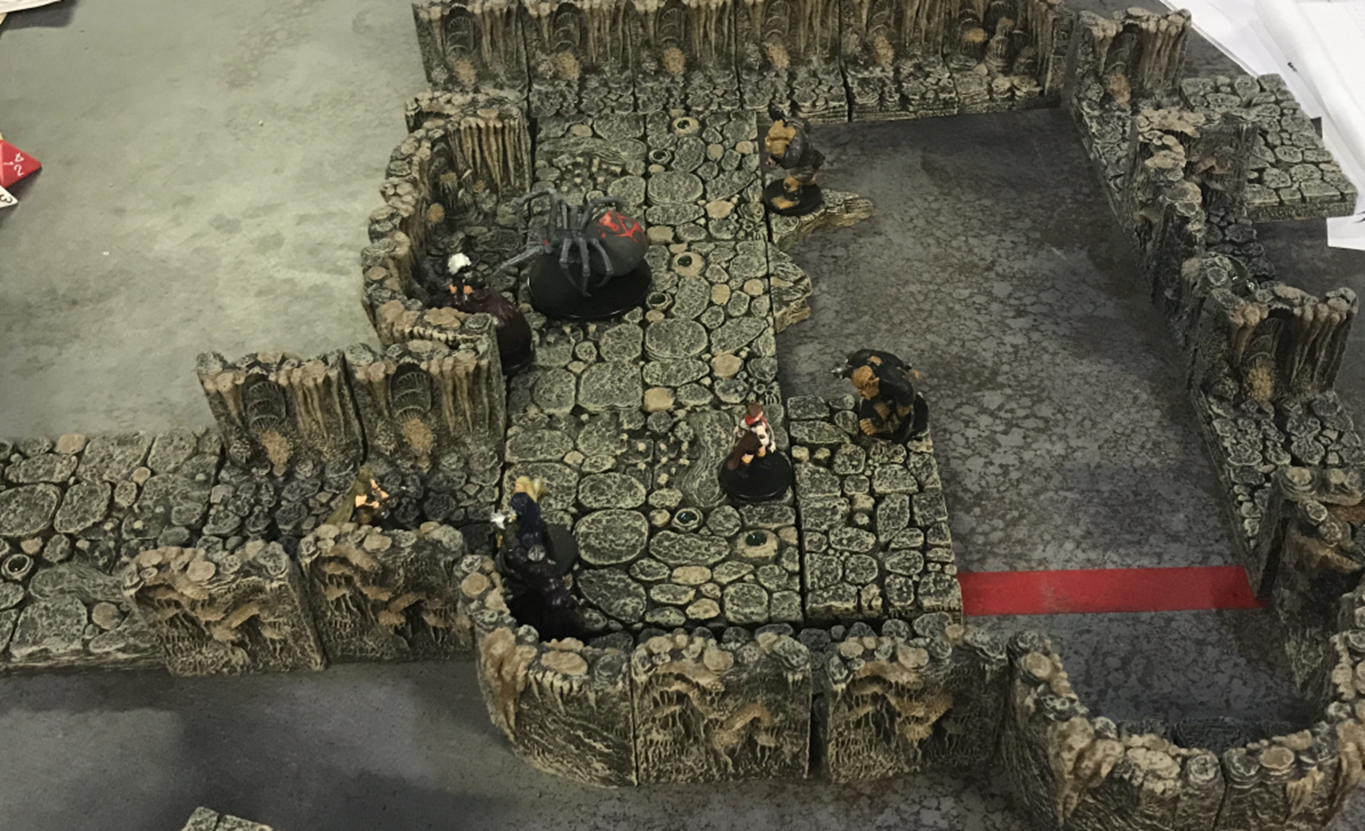
Of course, one reason the drow will never be the same is because he was a doppelganger! This isn’t the first doppelganger the party has fought, and they realised half-way through the battle something was wrong, based mainly on how the drow fought. Clever, clever players!
The party wanted to push the bugbears back over into the chasm below, but no luck. The bugbears kept making great Strength (Athletics) checks to resist the shove attempts. However, bugbears can’t survive when a group of adventurers is very good at dealing a lot of damage! The rogue using sneak attack and the ranger using Colossal Slayer did a significant amount of damage.
Soon enough, the party found their goal: the Black Spider – a drow who was behind all of the schemes and plots that had bedevilled them over the past few weeks. He was guarded by a pair of bugbears and four giant spiders – could the party defeat him?

The answer? Yes – with ease! Magic missiles from wand and spell struck the Black Spider and he died without being able to do more than taunt the characters. The bugbears proved a little more trouble, but they soon went down, and from there the characters used the cover allowed by the passage to fight the spiders without allowing more than one or two to attack. (Choke points work, boys and girls!)
With that, the adventure was pretty much done. There are more encounters in the mines, but we’d done the important ones. I find it important to leave out inconsequential encounters when you’re trying to tell a story in a limited amount of time. Getting to know when you can expand on the story, and when you have to just hit the important highlights is one of those DM skills you gain with experience.
Did the players enjoy the miniature use? Yes, they did. I probably should use miniatures more than I do, but just pick and choose the encounters in which I use them rather than insisting on them all the time (or not at all!) Miniatures aren’t needed for every combat. For really complex or really simple combats, miniatures can be a hindrance, but that leaves a lot of room to use minis.
In two weeks time, Tomb of Annihilation will start… and I expect to be blogging about it as my players explore the jungle land of Chult!

Hi
I am about to construct a Dungeons and Dragons (5th Edition) club at my local school. I spoke to pupils today and they are very excited.
May I enquire as to the availability of reasonably priced figures that would complement the 5 pre-generated characters that come with the Starter Kit?
I am hoping to introduce Traveller, Star Wars (FFG) RPG (and perhaps Advanced Squad Leader). Do you know of miniatures for Traveller or Star Wars?
Hugh
These ones would probably work: http://amzn.to/2zpdGf2
I don’t know any currently-made minis for sci-fi settings, although Reaper Miniatures may have some unpainted ones in their Bones range. There have been Star Wars miniature games in the past; you can probably find some on second-hand sellers and miniatures stores.